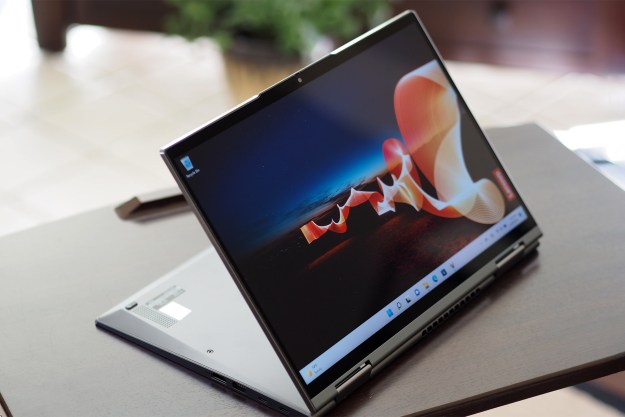
Right now there are no hardware specifics, and the product information card merely said that the monitor will provide “smooth, stunning, and seamless gaming.” It will sport an “ergonomically designed stand with tilt, swivel, pivot, and height adjustment.” There’s no name assigned to the monitor given it’s a prototype, but we’re betting it will eventually fall under the company’s Republic of Gamers brand when (or if) it hits the market.
Given this panel provides a 144Hz refresh rate, gamers should see super-smooth frame rates and movements at a super-high resolution. There’s no indication if the panel supports Nvidia’s G-Sync or AMD’s FreeSync technologies, which would make sure the refresh rate stays in sync with the frame output of the supported GPU, preventing screen tearing and lag.
Having a high refresh rate is important. Just as movies and TV shows have individual frames that are displayed numerous times per second to give the illusion of movement, monitors update the screen numerous times each second as well. Thus, if the monitor is capable of 60Hz, it’s essentially updating the screen image 60 times each second. Thus, the more the image refreshes each second, the smoother the visual experience.
The new prototype from Asus will seemingly replace the just-launched ROG Swift PG279Q monitor for gamers, a 27-inch panel unleashed during Computex based on IPS technology sporting a 2,560 x 1,440 resolution, a 165Hz refresh rate, Nvidia’s G-Sync technology, and 178-degree viewing angles. Like the prototype, this panel also includes an ergonomically designed stand with full tilt, swivel, pivot, and height adjustment.
If the prototype follows the Swift PG279Q, then it will include such Asus proprietary features as Ultra-Low Blue Light, Flicker-Free, GamePlus, and GameVisual technologies. There may also be a dedicated “turbo” button built into the frame for quickly selecting refresh rate settings ranging from 60Hz to 144Hz. The highest refresh rate will likely only be accessed through the DisplayPort connector while the 60Hz refresh rate will only be supported by the HDMI port.
On a technical level, the current Swift PG279Q has a maximum brightness of 350 nits, a maximum contrast ratio of 1,000:1, a response time of 4ms (gray to gray), and support for 16.7 million colors. There is one HDMI port, one DisplayPort jack, a 3.5mm earphone jack, one USB 3.0 port that connects to the computer and two USB 3.0 ports for adding peripherals, and two built-in 2-watt speakers.
That said, the prototype display likely has the same hardware features. However, Asus notes that the Swift PG279Q has a refresh rate of 144Hz by default. The only way to reach 165Hz is to have a Nvidia GeForce GTX 960 or higher graphics card installed in the PC.
The other monitor revealed during Computex, the Swift PG27AQ, is also a 27-inch panel, but it sports a higher 3,840 x 2,160 resolution (163 PPI). It utilizes Nvidia’s G-Sync technology too, and we’re betting the unnamed prototype will support Nvidia’s technology as well. so is this panel and the prototype the same unit then? No. The PG27AQ is only capable of 60Hz through the DisplayPort jack and 24Hz through the HDMI port when the resolution is set to 3,840 x 2,160. The refresh rate jumps up to 60Hz via HDMI when the resolution is lowered to 1,920 x 1,080.
We presume that we’ll hear more about the prototype monitor in the near future. Then again, because it’s a prototype, it may never hit the market. But we’re talking about Asus here, so we expect to see a marketable version at next year’s conference if it doesn’t become a full-fledged product by the end of the year.
Editors' Recommendations
- Asus’ 4K, 32-inch mini-LED gaming monitor might hit the perfect sweet spot
- LG finally did it: a 27-inch OLED gaming monitor with a 240Hz refresh rate


